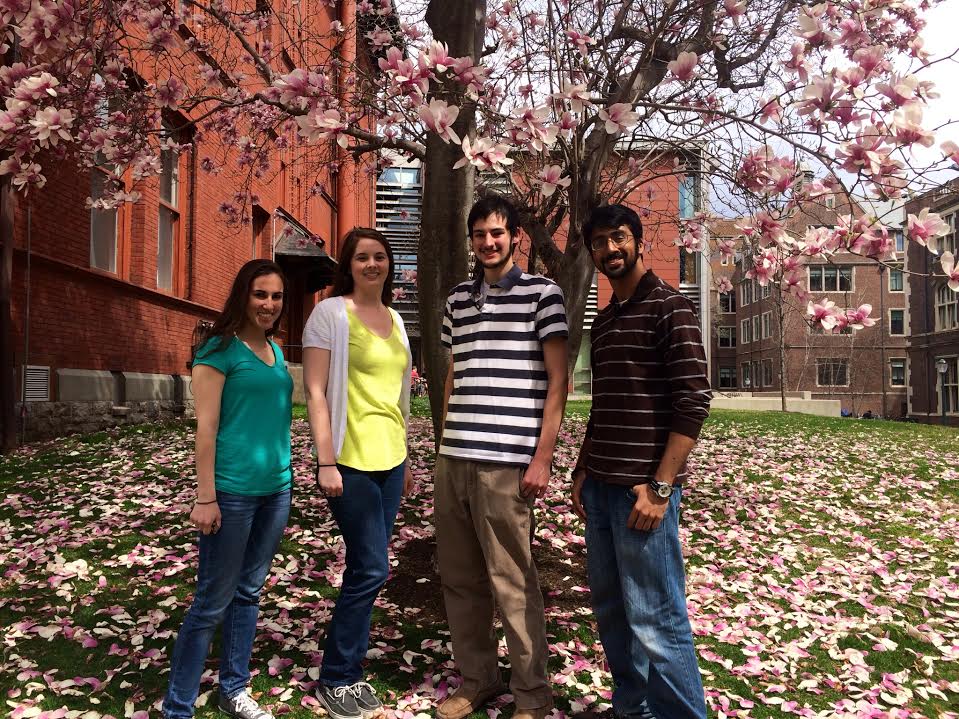Four Chemistry Department students have been awarded fellowships in the National Science Foundation Graduate Research Fellowship Program (GRFP). John Ferrie (Petersson group); Roy Malamakal (Chenoweth group), and Rachel Roesch & Mary Rose Mintzer (Gai group) all received fellowships.
Geraint Davies and John Tellis of the Molander group both received honorable mentions.
Since 1952, the program has recognized and supported outstanding graduate students who are pursuing research-based graduate degrees in fields within NSF's mission. The GRFP provides three years of support for the graduate education of individuals who have demonstrated their potential for significant achievements in science and engineering research.

2014 NSF Winners (right to left)
Rachel Roesch, Mary Rose Mintzer, John Ferrie, & Roy Malamakal
Winning Proposal Summaries
Rachel Roesch:
Despite the extensive research that has been conducted in the field of protein folding over the past several decades, a comprehensive understanding of the molecular mechanisms and predictability of such phenomena is still elusive. This is due in part to the fact that existing experimental methods lack either the temporal or spatial resolution necessary to yield highly detailed snapshots of conformational intermediates and/or substates populated along the folding pathways. In order to improve our ability to trigger and probe protein folding dynamics with enhanced structural resolution, my proposal aims to test/develop two experimental methods. First, I seek to develop a new disulfide bond triggering method that offers improved control over the initial state of folding or unfolding. Secondly, I propose to use thioamides to determine the role of individual backbone-backbone hydrogen bonds in controlling protein folding dynamics.
Mary Rose Mintzer:
It is extensively studied and well understood that bulk water plays an essential role in ensuring the proper folding of proteins to their biologically functional states. However, the role of buried water molecules is far less described though the water molecules can participate directly in its function. Recent studies suggest that water can situate, either transiently or permanently, within a hydrophobic cavity inside a protein and create a high polarizability in the cavity. However, directly probing the dynamics of water molecules that are bound to the interior of a protein is difficult. Herein, I propose to use two-dimensional infrared spectroscopy, a technique that is capable of monitoring the picosecond timescale of hydrogen bond fluctuations, and a site-specific infrared probe, the thiocyanate (SCN) moiety, to quantitatively investigate the motions of individual confined water molecules in hydrophobic cavities. In addition, I aim to use this SCN probe to quantify the local electrostatics of the cavity.
John Ferrie:
Alpha-synuclein (αS) misfolding and aggregation leads to the formation of Lewy Bodies, which are observed post mortem in patients suffering from Parkinson's Disease. Lewy Bodies are intracellular inclusions comprised of β-sheet rich fibrils which form from early oligomers of αS. However, the oligomeric structure of αS is very poorly defined, and the oligomer size at which β-sheet characteristics become apparent is unknown. Moreover, the intrinsically disordered nature of αS suggests that folding is correlated with the aggregation process. Therefore, the ability to specifically link oligomer sizes directly with explicit αS conformations would provide a more powerful description of folding events. The proposed method highlights the potential of coupled single molecule fluorescence polarization anisotropy and Förster resonance energy transfer (smFPA/FRET) to obtain measurements of oligomer size and intramolecular distances, respectively. By rapidly switching between excitation of the FRET acceptor, to measure FPA, and excitation of the FRET donor, to measure the energy transfer distance, while monitoring acceptor emission, full characterization of both size and conformation can be obtained for each oligomer passing through the observation volume. Finally, applying the empirical folding constraints to computational studies will allow for the development of a cohesive picture of αS folding during continued aggregation.
Roy Malamakal:
The synthesis of a novel organic semiconducting material is proposed. Over the last thirty years, the tetrathiafulvalene core has received considerable attention as a scaffold for the synthesis of highly electron mobile organic electronics. In an effort to improve upon these substrates, up to two sulfur atoms on the core have been replaced with nitrogen atoms; however, these modifications have typically been met with issues with air stability. One particular variation which has not been explored has been directly maintaining the lone pairs on nitrogen in aromaticity within a pyrrole ring fused to the fulvalene core. Such a change is expected to improve the electron donating capacity of the substrate while reducing the capability of the substrate to oxidize. Examining a number of synthesized derivatives of this core will not only provide new insight into the development of optimized electrical devices, but will also help build a library of compounds with improved semiconducting performance.
